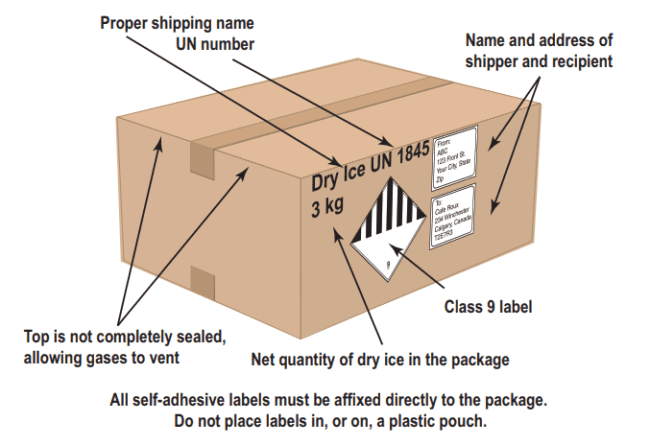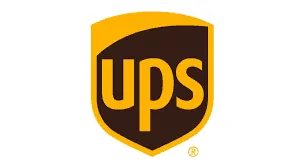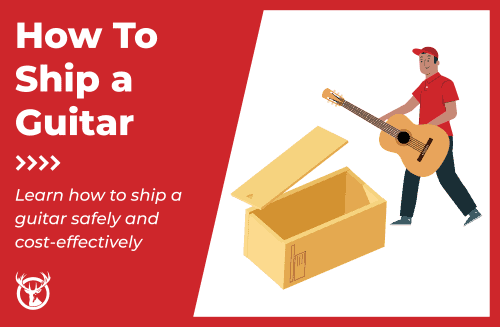Nothing beats opening the mail or a package to find sweet, savory, or other delicious cold treats. However, that all goes away if the sender doesn’t know how to ship frozen foods and the products arrive in a melty pool.
So, if you’re going to send frozen foods and goodies to people across the U.S., there are dangers to consider and options to use. You need to protect every snack, keep it cold, and get it to people quickly. At Red Stag Fulfillment, we have experience shipping a wide range of products. We have turned to our experts, plus information from major carriers, to help you figure out how to ship frozen foods and avoid spoiling the food or the recipient’s joy.

The 3 things to worry about
When you’re considering how to ship frozen foods, the main goal is to have them arrive safely enough that you can still consume or sell them. That means maintaining the appropriate temperature throughout and having a ready way to store them at the destination. Frozen foods and other perishables will have some consistent concerns, and you want a specific plan to address each before you start your shipment. Let’s look at a few of the most common.
Temperature controls
Your frozen foods have specific temperature ranges they need to stay within to arrive at their destination without spoiling. Temperatures depend on the food and can vary among SKUs and shipments. So, depending on the size of your frozen shipment, you’ll have a few different options for maintaining temperatures.
Options often depend on the carrier’s technology and your capabilities. In some cases, you may ship frozen foods in full truckloads in a truck with its own refrigeration unit. These can help maintain consistent temperatures for long distances. If you cannot use a reefer truck or only have small shipments, temperature control will depend on ice, cool packs, and other elements in your box.
Depending on how you’re shipping goods and the products themselves, you may have regulatory temperature requirements and need to include sensors to ensure that appropriate temperature levels were kept throughout the journey.
Humidity
You know that air temperature impacts your ability to keep goods frozen. However, humidity plays a role in this, too, because moisture can encourage the growth of bacteria and mildew or even thaw foods. Certain foods may store and stay best at different humidity levels. So, you’ll want to match humidity for your food’s transportation and consumption.
Packaging and damage
When you think about how to ship frozen foods, you want to pay close attention to the packaging and box. This is where you’ll make the most effort to maintain temperature and humidity levels through design. Insulated boxes, foams, strong tape, cold packs, and other options can all give you a good seal to protect internal temperatures and keep things frozen. Seals should be leak-proof but not air-tight so that packages safely vent gas from evaporating dry ice.
On a related note, packaging needs to be strong and should often be reinforced options. This is to prevent a box from breaking and having warm outside air leak into the box. Sturdy materials can take some denting and bending without breaking the seal or puncturing. That’ll help you keep goods frozen during the entire transit.
Best practices for how to ship frozen foods
Before we look at carrier-specific considerations for how to ship frozen foods, there are some general guidelines and tips that’ll help you prepare your order. This is true if you’re sending frozen peas as part of a recipe to a family member or if you’ve launched the next great food-box subscription.
- Learn and clearly articulate the specific needs of your foods. Write this down.
- Look at multiple carriers to determine available options. Ask them specifically about shipping frozen foods.
- Ship items as quickly as possible. The longer they’re in transit, the more you must do to maintain temperature.
- Match packaging and materials to your specific needs—more on that below.
- Store foods correctly before you send them. Make sure the recipient can store them as well.
- Label shipments as necessary and attach required notices, such as hazardous materials labels if you’re using dry ice.
- Don’t forget to protect your foods from the inside of the box! For instance, wrap goods in plastic before placing them in a container with dry ice.

Packaging and materials
Packaging for how to ship frozen foods safely has its own set of needs. These will change depending on specific foods and if you’re shipping a single package or in bulk. One quick note is that you should never fully wrap your dry ice because the released carbon dioxide can explode if it isn’t able to expand.
However, here are best practices that apply broadly:
- Choose insulated boxes or add foam to create your own insulation
- Sturdy, insulated foam containers like the cooler you might pick up for a weekend camping trip are recommended by some carriers
- Use a box that creates as snug a fit as possible
- Fill any void space with bubble wrap and fillers to limit movement as much as possible
- Fillers should focus on volume-control and reducing available space for air
- Dry ice is generally viewed as the best way to keep foods frozen; gel packs are best for keeping foods between 32°F and 60°F.
- Wrap foods that can melt in plastic to minimize any impact if something thaws
- Thoroughly seal the package and then affix any necessary labels
Some frozen products also have best practices, such as bagging frozen seafood twice. Some companies recommend adding one pound of gel as a backup for every three pounds of meat if you’re shipping frozen meats.
You’ll want to look at potential restrictions for any packaging materials too. While uncommon, there are some that apply here. For example, there are some dry ice restrictions for air shipments if you’re using more than 5.5 pounds of it. Generally, the only exceptions to these kinds of rules are for medical and laboratory materials.
How to ship frozen foods with major carriers
Each of the three major U.S. carriers has options that can work for frozen foods. Some are better suited than others. Here are their recommendations and some requirements. We recommend you work with a carrier directly or via a 3PL, and don’t neglect to look for local and regional carriers that may specifically work with refrigerated and frozen products.
FedEx
FedEx has specific services to help you ship frozen items, especially if you’re considering making this part of your business. The carrier has large, pallet-sized containers for clinical and pharmaceutical goods as well as many for shipping frozen foods. It offers guidelines for using dry ice and will walk you through the process of labeling and packaging your frozen items. Businesses should consider using its SenseAware shipments that track temperature for your parcels, enabling you to ensure that goods remain properly cold throughout their movement.

FedEx outlines some other preferences and options available for you:
- Create sturdy frozen food packaging or use one of its pre-configured options
- Packaging must be able to withstand a minimum of 24 hours in transit
- Foam containers must be placed within outside packaging, and it recommends using foam in 1-1/2” or 4cm in thickness or greater
- Mark boxes appropriately, such as noting the weight of the dry ice
- Use either a fast service or one of its temperature-controlled options
- FedEx Express should get it to your destination within 24 hours
UPS
UPS places emphasis on shipping frozen items in the proper containers. It recommends using think foam with outside packaging while creating a space for dry ice. It specifically notes (multiple times on its website) that regular ice doesn’t work well, so avoid that common mistake.

“You need to make sure dry ice doesn’t adversely affect the quality of the shipped product,” Quint Marini, package engineering manager at UPS Package Design and Test Lab, says on the UPS site. “It might make sense to combine [dry ice] with other coolants such as frozen gel packs.” That’s especially true if transit time is more than a day.
Other UPS considerations include:
- Look for regulations around dry ice, including the 5.5 lbs. weight limit in the air and any international restrictions
- Use as thick of foam containers as possible
- Consider the Next Day Air option to get it to your destination in 30 hours or less
- Contact its Cold Chain services for freight questions because they’re willing to make recommendations or provide support even outside of healthcare settings
USPS
The Postal Service doesn’t have a specific cold or frozen shipping option. However, they offer some flexibility for shipping frozen foods because it’s much easier to ship something like a sealed cooler with its services. The flexibility does come with more requirements and work on your part.

Here’s how to ship frozen foods with USPS:
- Use sturdy, leak-proof packaging
- Dry ice is acceptable for domestic shipping but is limited to 5 lbs. per mail piece on air
- Dry ice requires the appropriate label and must be declared on the outside of the package
- Packages must be marked with the weight of the dry ice and the names of all foods they contain
- It recommends Priority Mail and Priority Mail Express services for mailing items requiring refrigeration
- USPS faces restrictions for mailing produce to certain areas of the country (i.e., Florida, Hawaii, California), so review the service’s FAQ
High-volume shipping requires a partner
If you’re wondering how to ship frozen food for a business application, your best bet is to start reaching out to 3PLs. You want someone with specific handling capabilities for your industry and products. This includes strict warehouse capabilities, sensor and technology support, the ability to monitor across the entire cold chain, and guarantees for safety.
If you’re wondering how to start evaluating them, begin by asking standard 3PL questions and mix in some specific to hazardous material labels, dry ice use, and how they ensure your products arrive quickly.
For more in our “How to Ship” series, check out these options:









